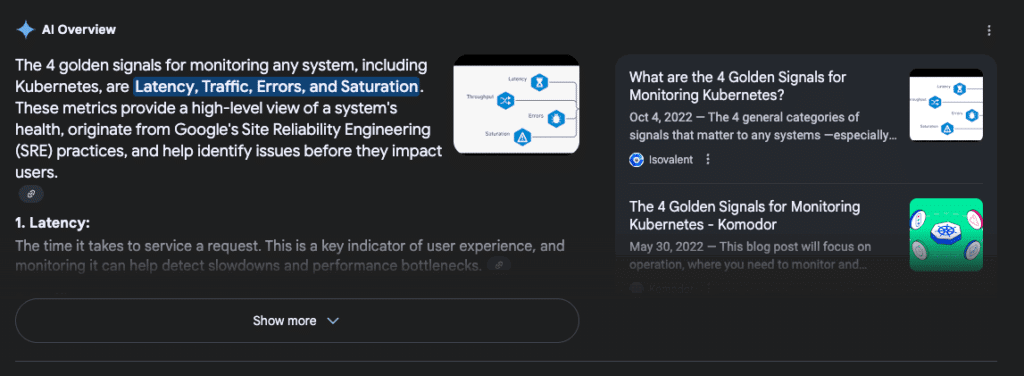Key Takwaways
- Tech buyers search for solutions, not lists.
- Long-tail, problem-focused queries convert better
- Content that solves real issues builds trust and drives retention
You may have focused on keywords like “top Kubernetes platforms” or “best observability tools,” as marketing platforms typically recommend. It’s a reasonable approach because you’re aiming to capture high-volume search traffic.
However, this is not how your technology buyers search for solutions. They are not looking through list articles; instead, they are trying to address specific technical and business problems. Technical buyers spend their time debugging toolchains, configuration files, or logs and alerts. If your content does not appear as a top result at these critical moments, you risk being overlooked.
Content shouldn’t just attract visitors; it should answer the question your buyer hasn’t even said out loud yet. That’s how you earn trust early, shorten sales cycles, and keep post-sale engagement high.
Working with several developers, CTOs, and cybersecurity engineers over the years, we’ve deeply explored:
- The gap between SEO theory and reality in the technical space
- Long-tail keyword strategies
- Real-world examples and case studies
- Crafting well-researched niche queries
- Creating qualified pipeline opportunities
Here are some of our key learnings from years of research and content building.
Why Traditional SEO Doesn’t Work for Technology Buyers
The moment we joined our first developer-driven go-to-market project, we saw the disconnect. Marketing teams were optimizing for head terms like “top observability tools,” while engineers searched for different terms.
For example:
| What marketers optimize for | What engineers actually search for |
| “Best log monitoring tools” | “opentelemetry collector dropping spans after upgrade” |
| “Best service mesh” | “Istio Transport Layer Security (TLS) passthrough ingress example” |
| “CI/CD platforms comparison” | “Argo workflows restart on failure policy” |
These aren’t isolated cases. We’ve seen this same trend across every ideal customer profile (ICP) from infrastructure to security, to data products, and more. Developers don’t search for categories; they search to validate, compare, or unblock their needs. When content aligns with that moment of necessity, the greatest chance for conversion occurs.
Inside the Engineer’s Google Window
We recently worked with a client specializing in network observability and network security. During a renewal discussion, we reviewed their customer journey logs and asked:
“What did the buyer search for right before they hit your demo request?”
Their Solution Engineer (SE) replied instantly:
“Surprisingly, they found us searching for ‘golden signals in Kubernetes”
That exact phrase led to a blog post we had published weeks earlier. The results for that post?
- Regularly linked on Hacker News and Stack Overflow
- Attributed to influencing $120K+ of pipeline adds in three months
- Now being quoted and attributed in Perplexity and SearchGPT responses
This happens often. We’ve seen similar results from queries like:
- “mTLS Istio configuration errors”
- “Istio alternative with mTLS support”
- “eBPF Kubernetes network mesh risks and benefits”
These searches go beyond just raising awareness; they are about validating solutions in real situations. Your content either provides the assistance users need, or someone else will gain their trust instead.
At GTM Delta, we train our teams to identify these queries, understand the engineering context behind them, and transform that insight into content that is ready to drive conversions.
Why Long-Tail Keywords Convert
When we say long-tail, we don’t mean low-value. We mean high-intent, high-signal.
Here’s what defines long-tail for technical audiences:
| Attribute | What it Looks Like |
| Specific | Includes configuration terms, tool versions, and file paths |
| Problem-oriented | Mentions error messages, broken behaviors |
| Contextual | Name specific integrations, environments, and workflows |
So, instead of building for generic searches (e.g. “opentelemetry datadog”, “vault agent crash”) we create highly-specific phrasing that maps to real customer searches:
- “opentelemetry to datadog via otlp grpc”
- “vault agent sidecar crashloop on initContainer”
- “Prometheus federation scrape interval mismatch EKS”
These queries don’t show up in traditional SEO dashboards. However, they represent the exact high-intent, problem-solving searches that lead to conversions. They’re hard to find, but impossible to ignore if you want qualified traffic.
We source them by:
- Scraping GitHub issues and Stack Overflow
- Interviewing SEs and asking, “What do you search when stuck?”
- Mining sales call transcripts with AI classifiers tuned for frustration signals
Then we turn those pain points into structured, summarization-ready answers.
How You Can Create Content That Satisfies Technology Buyer Search Intent
If you want to engage technology buyers, start by mapping your content to how they evaluate. The best technical content aligns tightly with search intent and solves real engineering problems.
Here’s how to structure your content so it supports the full buying journey from pre-sales evaluation to post-purchase success:
| Step | What to Do | Why It Works |
| Capture evaluation paths | Interview your SEs. Review support tickets. Ask: “What were they trying to fix?” | You build from what buyers actually search. |
| Map queries to journey stages | Tag each keyword to validation, implementation, or troubleshooting. | Your CTA and format stay aligned with the buyer’s mindset. |
| Structure for signal | Use H2s that match questions, add annotated YAML, and call out tradeoffs. | You get quoted by models and trusted by readers. |
| One problem per post | Solve one issue well. Don’t overload with ten topics. | You rank for precision queries and build authority. |
| Measure real conversion | Don’t just track views. Track trials, adoption, and retention. | You prove that your content drives revenue. |
For example, one post we wrote on a Helm upgrade issue included:
- The exact values.yaml delta that caused the failure
- The logs from the otel-collector sidecar
- A working patch with CI-safe override injection
It got some early traction with escalating weekly views. It also drove 6 enterprise trials identified by readers who explored more content and then started a trial.
Why Engineers Read (and Share) Our Content
We don’t write “marketing content.” We write deep technical content wrapped in a product context and a strong narrative story.
Our team pairs a practicing technologist with an expert marketer. We are the nerds who’ve been debugging kubectl race conditions. We’ve configured mTLS by hand. We know the moment an engineer needs an answer and how they search for it. That’s why we write:
- With clear headers that reflect search queries
- Using terms developers use in code and day-to-day discussions
- Focused on tradeoffs, not pitches and slogans
We’ve had content quoted in AI Overviews, LinkedIn DevOps newsletters, and even cited in internal runbooks at Fortune 500s. Because when you solve the problem well enough, people bookmark it and share it.

We like to say that we know your audience because we are your audience.
How to Structure Content for AI Search Engines
AI Overviews, Perplexity, and Bing Copilot don’t just index content. They summarize it and they quote the clearest, most structured content available.
To rank in this zero-click world, write like you’re answering a prompt:
- Use headers that reflect search intent
- Lead with the answer, not the background
- Follow up with real YAML, decision tables, and working examples
In one example, we wrote a post on routing tenant traffic in Istio. We opened with architecture decisions, followed by annotated configuration, and closed with a tradeoff matrix comparing Server Name Indication (SNI) and header-based routing. That structure got the post quoted in multiple LLM platforms and drove targeted traffic straight into the sales pipeline.
The takeaway: Write answers, not essays. You can satisfy both the reader and the search engine if you’re artful in your delivery.
Stop Guessing, Start Solving with GTM Delta!
Technical buyers don’t search for “solutions.” They search for what’s broken. If your content speaks to that moment, your brand earns trust before the first call.
Content shouldn’t just attract visitors; it should answer the question your technology buyer hasn’t even said out loud yet. That’s how you earn trust early, shorten sales cycles, and keep post-sale engagement high.
You can build that kind of content system yourself. Or you can work with a team that’s done it dozens of times, across technical stacks, audiences, and use cases.
At GTM Delta, we don’t guess what developers search. We deliver the answers they already need across the full journey from first touch to ongoing adoption.
Schedule a call with us to map your content to the queries your buyers already type.






